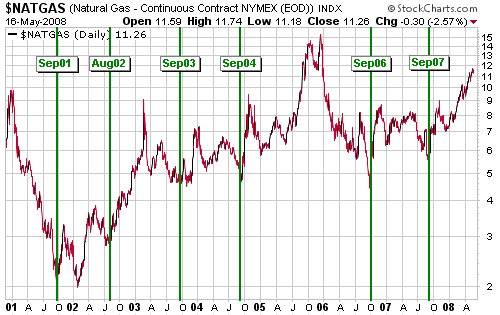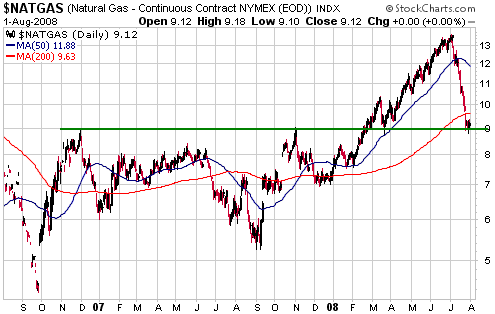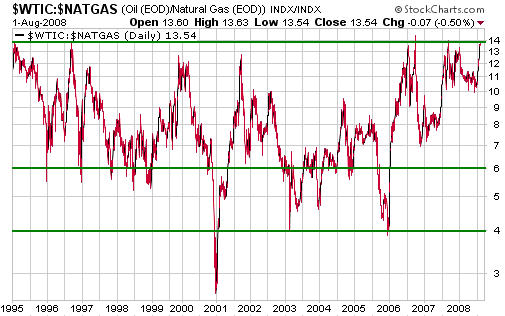|
TUESDAY EDITION December 23rd, 2025 |
|
Home :: Archives :: Contact |
 |
Natural Gas - Weekly Market UpdateSteve Saville steve@speculative-investor.com August 6th, 2008 Cycles The following discussion and chart were included in the 19th May Weekly Update: "For many years the natural gas (NG) market has exhibited a strong tendency to make an important bottom during August-September (usually September). Specifically, there were important lows in September of 2001, 2003, 2004, 2006 and 2007, and in August of 2002. In fact, over the past seven years the only failure of the August-September cycle occurred in 2005. This failure can be attributed to Hurricane Katrina. NG's August-September lows are indicated on the following chart.  Unless there's some very unusual weather in North America over the coming few months, such as an extended period of much higher-than-normal temperatures or a hurricane in the Gulf of Mexico of sufficient magnitude to curtail NG production, we suspect that there will be another August-September low this year." Taking into account the recent price action as well as the above-mentioned cyclical/seasonal tendency, the two most likely short-term NG scenarios can be described as follows: 1. The rapid pace of NG's recent decline caused the seasonal low to occur a little earlier than originally anticipated (during the final week of July rather than during August-September). If this is the case then a rebound during the first half of August will probably be followed by a pullback into September, with the September low being above the July low. 2. After a short rebound to alleviate the NG market's oversold condition, the downward correction will resume and lead to a traditional August or September low (probably September). Due to the severity of the July pullback, the August-September low won't be far below the July low. We currently favour the first of these scenarios, but either way the next upward leg in NG's bull market should be underway by the end of September. Current Market Situation The daily chart presented herewith shows that the NG price quickly fell from its early-July high above $13 to intermediate-term support at $9. A possible explanation for the steepness of the decline is that the preceding advance 'should' have ended during May when the price was $11-$12. By this we mean that the final 6 weeks of the rally were not supported by near-term fundamentals or seasonal factors. Had the NG price peaked during May at around $11.50 and then worked its way down to $9 by early August then the correction would have a more normal look about it.  While the NG market has made a good recovery over the past year in US$ terms, the following chart shows that the price of NG is presently near a 13-year low relative to the price of oil (the chart shows that the oil/NG ratio is near a 13-year high). This chart, we think, encapsulates the great investment opportunity offered by the NG market. If NG and oil traded at energy-equivalent levels then the oil/NG ratio would be around 6, or less than half its current level. However, given that NG is the more environmentally friendly energy source a reasonable argument can be made that NG should trade at a premium to oil. On this basis we think the potential exists for the oil/NG ratio to drop to around 4 over the next few years. In other words, we see the potential for the NG price to TRIPLE relative to the oil price.  We recently boosted our natural gas exposure by adding Chesapeake Energy (CHK call options, actually) and Precision Drilling (NYSE: PDS) to the TSI Stocks List. CHK is a trade with an expected duration of less than 6 months, while PDS is expected to be a longer-term investment. We suggest that traders average into CHK in the $40s (it might drop to the low-$40s, but it's more likely that the stock will bottom in the mid-to-high $40s) and that investors average into PDS in the low-US$20s. By the way, CHK has a policy of hedging almost all of its next two years of production. As a result of this policy the company's operating cash flow will generally be stable from one quarter to the next (the extensive hedging means that the current quarter's cash flow will be largely unaffected by changes in the spot NG price), whereas quarter-to-quarter earnings results will sometimes experience enormous swings due to hedging gains or losses. But even though its hedging policy means that current earnings will be hurt, rather than helped, by increases in the NG price, CHK provides considerable exposure to NG's upside due to its huge and growing in-ground reserves. The 'Gassy' Trusts We continue to like the 'gassy' Canadian energy trusts as long-term investments. These trusts have a stronger correlation with the natural gas price and a lesser correlation with the broad stock market than do E&P companies such as Chesapeake Energy, which is a definite plus if we are correct to assume that the broad stock market will remain in 'bear mode' for another year or so. Also, in a world of generally low stock-market returns the sizeable yields offered by most of the trusts should make them increasingly attractive to investors, particularly if there is a continuation of the recent trend towards higher monthly distributions (this trend will continue if, as we believe, natural gas is now in a bull market). The trusts currently don't pay tax on their profits as long as the profits are distributed to unit-holders. As a result, they are able to pay significantly higher distributions than would be the case if tax had to be paid at the trust level. The tax-advantaged status of the Canadian energy trusts is scheduled to end in 2011, which will be an issue for some investors. In particular, it will be an issue for Canadian investors that hold trust units in tax-deferred accounts and for foreign (non-Canadian) investors, because these investors will have their distributions reduced by the amount of tax paid by the trusts (the reduction will likely be 21%-27%). Note, though, that most of the trusts have large tax pools that will enable them to avoid tax at the trust level for years beyond 2011, so the expected taxation-related changes should not be a major concern at this time. Of greater concern right now are the higher royalties that oil and gas producers will have to pay to the Alberta Provincial Government starting in 2009. The full impact on our 'gassy' trusts of the increased Alberta royalties can't yet be assessed because a lot will depend on commodity prices (the higher the prices of oil and gas, the greater the potential impact of the new royalty structure). Steve Saville steve@speculative-investor.com August 6th, 2008 |
| Home :: Archives :: Contact |
TUESDAY EDITION December 23rd, 2025 © 2025 321energy.com |
|